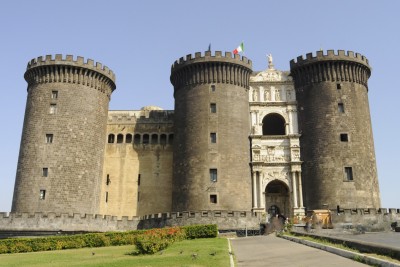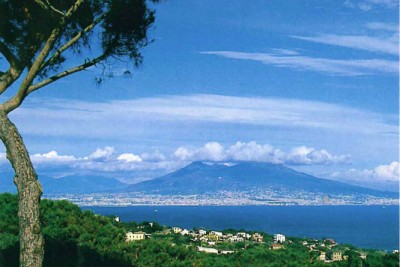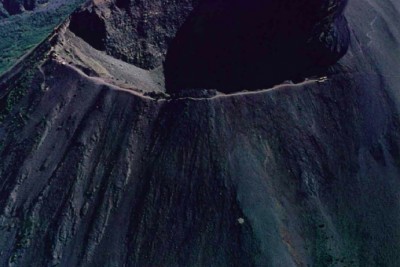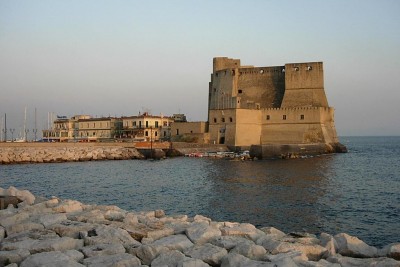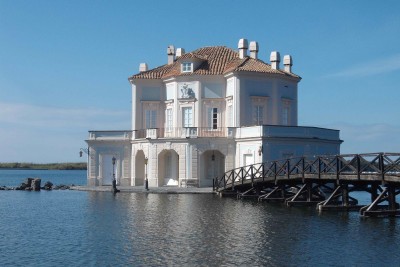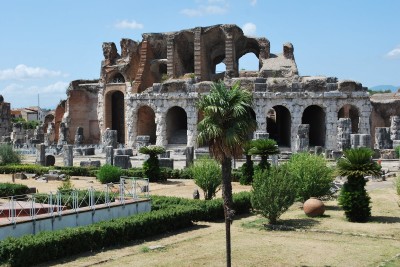Our Insider Guide to Naples - Part 3
Even with all its difficulties and contradictions Naples remains an extraordinary place to visit


The waterfront: from Chiaia to Posillipo
The waterfront between Castel dell'Ovo and Posillipo, with its view of the Gulf, Mt. Vesuvius and the islands, is arguably the most panoramic spot in Naples.
The profile of the coast is dominated by the massive wall of the Castel dell'Ovo (#42), the oldest of the city, that sits on the little islet of Megaris, or Megaride, facing the famous Santa Lucia neighborhood.

Castel dell'Ovo
The castle's name comes from a legend about the Roman poet Virgil, who had a reputation in medieval times as a predictor of the future. In the legend, Virgil put a magical egg into the foundations to support the fortifications. Had this egg been broken, the castle would have been destroyed and a series of disastrous events would have involved the city of Naples.
The Castel dell'Ovo is the oldest standing fortification in Naples.
The island of Megaride was where Greek colonists from Cumae founded the original nucleus of the city in the 6th century BC. Its location affords it an excellent view of the Naples waterfront and the surrounding area. In the 1st century BC the Roman patrician Lucius Licinius Lucullus built the villa Castellum Lucullanum on the site.
It was transformed into a convent in 492 AD. Under the Normans, in the 12th century, it became a fortress.
Roger the Norman, conquering Naples in 1140, made of Castel dell 'Ovo its seat.
The importance of the Castel dell'Ovo began to decline when king Charles I of Anjou built a new castle, Castel Nuovo, and moved his court there. Castel dell'Ovo became the seat of the Royal Chamber and of the State Treasury.
It also served as a prison.
A visit to the Hall of the Columns, so called because it re-used the large columns of the original villa, is a must. From the cannon terrace, on the high part of the castle, you can enjoy a marvelous view of the gulf.
Under the walls of the castle is Borgo Marinari (#43).
 Borgo Marinari
Borgo Marinari
Built in the 1800's, it was originally meant to house fishermen, their boats and their families. It now houses nautical clubs, restaurants, bars and trendy night spots.
Walking along the very famous via Caracciolo (#44, see below) you can enjoy some of the most beautiful scenery of Naples, from Mt. Vesuvius all the way to the hills of Posillipo.
 Via Caracciolo
Via Caracciolo
Via Caracciolo runs parallel to Villa Comunale (#45), the City Park, the former “Royal Gardens” designed by Luigi Vanvitelli at the end of the 1700's, and to the old waterfront called the Riviera di Chiaia.
 Villa Comunale
Villa Comunale
here you can visit the Zoological Station, (opened in 1872 by German zoologist Anton Dohrn) and the oldest Aquarium in Europe.
On the Riviera di Chiaia is the neoclassical Villa Pignatelli (#46).

Villa Pignatelli
It is the most striking building along the Riviera di Chiaia, the road bounding the north side of the Villa Comunale on the sea front between Mergellina and Piazza Vittoria.
It was built at the behest of Ferdinand Acton in 1826 as a neo-classical residence that would be the centerpiece of a park.
The central atrium was moved to the front of the building and Doric columns still catch the eye of the viewer from the street 50 yards (away. The villa maintains intact the gardens in front of the building and houses the Museo del Principe Diego Aragona Pignatelli Cortes, where the Bank of Naples keeps its rich collection of paintings.
Via Caracciolo ends in Mergellina, where according to legend the current dragged the lifeless body of the siren Partenope. Here too the view is breathtaking, with the hills of Posillipo and Vomero with Mt. Vesuvius in the distance.
The nearby Chiesa di Santa Maria di Piedigrotta (#47) was built on the site of an earlier 14th century church established where an even older chapel sheltering a wooden Byzantine icon of the Virgin was erected. Legend holds the Virgin appeared to three individuals requesting the church to be built.
 Chiesa di Santa Maria di Piedigrotta
Chiesa di Santa Maria di Piedigrotta
It has undergone a number of restorations including in 1520, 1820, and 1853.
The present facade dates from 1853, and was designed by Errico Alvino, with sculptures by Bernardo Manco.
The adjacent cloister was designed by Tommaso Malvito. In the chapel of the Madonna di Pompei are a Crucifixion and a Pietà with Anthony of Padua by Wenzel Cobergher.
Between the Chiesa di Santa Maria di Piedigrotta and the Mergellina Station is the entrance to the Park of the Tomb of Virgil, one of the most visited sites of the Grand Tour.
The park hosts the so-called tomb of Virgil, a 15th century AD sepulcher identified with the burial of the poet.
In 1939 the tomb of another great poet, Giacomo Leopardi, who died in Naples in 1837, was also transferred here.
Leaving the waterfront behind, going on to the Western district, in piazzale Tecchio you will find the Mostra d'Oltremare; a large exhibition center built in the 1930's.
The area of about 700.000 square meters houses buildings, gardens, fountains and a large open-air arena the serves as a theater.
The large Palazzo Donn'Anna (#48) sits prominently at water's edge at the beginning of the Posillipo coast, just west of the Mergellina boat harbor.

Palazzo Donn'Anna
The building is on the site of the so-called "Rocks of the Siren" and, indeed, was originally called La Villa Sirena.
The original building on the site was probably built in the early 15th century.
It changed hands a number of times and finally was inherited in 1630 by the woman whose name it now bears, Anna Stigilano, who had it redone by architect Cosimo Fanzago in the 1640s.
At the extreme end of the promontory of Coroglio is the Villa del Pausilypon, the remains of the luxurious home of Publius Vedius Pollio, one of Augustus' supporters. Upon his death, the property went to the emperor.
The grandiose villa was composed of several buildings erected between the 1st century BC and the 4th A.D., to cover an area of about 9 hectares, or 17 acres.
At the center was the huge residential structure, around which were built a grandiose theater, an odeion and thermal baths.
Apart from its private dock on the Gala dei Lampi, the complex included its own roads and the tunnel known as the 'Grotta di Seiano', that crosses the rocky coastline to Coroglio, which today is the point of access to the complex.
The most spectacular panorama of Posillipo is enjoyed from the Parco Virgiliano, a park located on the top of the hill.
 Parco Virgiliano
Parco Virgiliano
Among the trees, gardens and sporting facilities, one's eyes roam over the entire Gulf of Naples, the Phlegrean Fields, and over to the sea, from which the island of Nisida emerges.
In the 1800's this magical scenery inspired a generation of painters, known as the School of Posillipo. Their rendering of this enchanted panorama did much to contribute to the fame of the beauty of Naples.
The hills: from Vomero to Capodimonte
The Vomero district was built in the 1800's, in a green zone famous for its views of the Gulf. Today the small Liberty Style villas exist side by side to modern buildings, in one of the most lively neighborhoods of Naples, with a wealth of shopping attractions.
Right off piazza Vanvitelli, the heart of the Vomero, is Villa Floridiana (#49), a gift of Ferdinand of Bourbon to his morganatic wife Lucia Migliaccio, the Duchess of Floridia.

Villa Floridiana
The elegant building, built by Antonio Niccolini and surrounded by a large park with fake ruins, sumptuous paths, fields and a panoramic terrace, today houses the Duca di Martina Ceramics Museum. The nucleus of the collection are the pieces donated by the heirs of Placido De Sangro, Duke of Martina, an avid collector of coral, ivory, snuff-boxes and most of all porcelain and majolica.
The collection of porcelain from Capodimonte and the Far East are especially interesting.
From Piazza Vanvitelli you can get to the top of the hill (with an escalator, if you wish), to the Castel Sant'Eimo and the Certosa (or Charterhouse) of San Martino.
Castel Sant'Elmo (#50) dominates the city with its imposing profile. With the nearby charterhouse, it is visible from many parts of Naples.
 Castel Sant'Elmo
Castel Sant'Elmo
This massive fortress was built in the 1300's by Robert of Anjou and completely restored under the Pedro de Toledo government (1537-1546).
The ground plan forms a six-pointed star; part of it carved into the tufa rock, and is surrounded by bastions and moats.
From there you can enjoy a 360° panorama of Naples.
In 1587 the munitions depot of the castle was struck by lightning and exploded, destroying the church, the chaplain's house and the officers' quarters.
Reconstruction was carried out between 1599 and 1601.
For centuries it has been a symbol and bastion of government oppression. In 1604 it was used to imprison Tommaso Campanella, branded as a heretic, and in 1799 the patriots of the Neapolitan Revolution.
Next to the Castle is the monumental complex of the Certosa of San Martino (#51), also projected by Robert of Anjou. It was begun in 1325, and later transformed in the 1500's and the middle 1600's by the most noted architects of the day, Dosio, Fanzago, thus becoming the most complete example of Neapolitan Baroque and one of the city's most grandiose monuments.

Certosa di San Martino
The inside of the church is a triumph of frescoes, sculptures, polychromatic marble and paintings. The frescoes were done by, among others, Giovanni Lanfranco and Battistello Caracciolo.
The presbytery and the sacristy are also richly decorated, with oils by Ribera, Massimo Stanzione and Guido Reni, wardrobes and choir-stalls of inlaid wood.
The vault of the Cappella del Tesoro is decorated with the luminous fresco by Luca Giordano, The Triumph of Judith.
The halls around the cloister house the Museo Nazionale di San Martino.
The museum has sections dedicated to sculpture and painting, minor arts and theater. The section dedicated to the scenes of the city is very important, starting with works from the 1400's and including the famous Tavola Strozzi.
Particularly interesting is the cribs' section made up of works by artists from the 1700's and by two exceptional groups of works: the wooden figurines of San Giovanni a Carbonara from the 1400's and the Cuciniello Crib from the 1800's, named after its donor.
Finally, do not miss the Prior's Apartment (the restored living quarters of the Prior), set in a very panoramic position, and the beautiful gardens of the convent. The highest point of the city is the Eremo dei Camaldoli, an hermitage at 457 mt above sea level.
It was built in 1585 and has a splendid view over the Gulf, the islands and the Phlegrean Fields.
At the edge of the urban weave of the hill, the nearby Camaldoli Park also merits a visit.
From Camaldoli, going down along viale Colli Aminei, you arrive to Capodimonte. The name derives from the late Latin "Caput Monte" (top of the mount) and clearly indicates its position: a hill on the highest part of the City.
Here rises the Palazzo Reale di Capodimonte (#41), or Royal Palace of Capodimonte, surrounded by a vast park. Charles of Bourbon, a dedicated hunter, built a hunting lodge here that was later enlarged to house the precious Farnese collections. The building, designed by Antonio Medrano, was finished in 1839.
 Museo di Capodimonte
Museo di Capodimonte
Located in the immense park are the hunting lodge of Vittorio Emanuele II, the small “lodge of the Queen”, the Chapel of San Gennaro, the building of the 18th century porcelain factory of Charles of Bourbon, the hermitage of the Cappuccini monks and the Fagianeria (pheasant breeding facility).
Today, the Royal Palace is home to the Museo Nazionale di Capodimonte, or National Museum of Capodimonte, one of the most important in the world for painting and the decorative arts.
The main nucleus of the Museum is the Farnese Collection, started by Pope Paul Ill and inherited by Charles' mother, Elisabeth Farnese. The picture gallery has more than 200 masterpieces by Masaccio, Botticelli, Raphael, Ribera, Titian, Mantegna, Correggio, El Greco, Lorenzo Lotto, Parmigianino, Carracci, and Bruegel.

Museo Nazionale di Capodimonte, "The Flagellation of Christ", by Caravaggio)
There are also two drawings done by Raphael for the 'Segnatura Room', and by Michelangelo for the Pauline Chapel in the Vatican.
The gallery of 13th-19th century Neapolitan painting has the painting of Saint Ludovico of Tolosa, by Simone Martini, the evocative Flagellation by Caravaggio, and again the works of Ribera, Luca Giordano, and Francesco Solimena.
The section dedicated to the 1800's is rich with the School of Posillipo painters, from Anton Smick Pitloo to Giacinto Gigante, and the masters of Naturalism, like the Palizzis.

Museo di Capodimonte, "Storm on the Gulf of Amalfi", by Giacinto Gigante
The many artists of the late 1800's and early 1900's- from Domenico Morelli to Vincenzo Migliaro - complete the artistic panorama.
The contemporary section is renewed by the presence of artists such as Alberto Burri, Andy Warhol, Carlo Alfano and Mimmo Paladino.
The Museum holds other surprises such as the Historic Apartment, with the porcelain sitting room of Queen Maria Amalia. The collection of decorative arts is one of the richest in all of Italy with unique works like the precious Farnese Box and the wall tapestries of d'Avalos, and the exceptional porcelain works like the Aurora Cart by Filippo Tagliolini.
NAPLES GUIDE-MT. VESUVIUS & POZZUOLI (PART 4)
For printing our entire Naples Guide (facing pages) you can download the PDF by clicking HERE
For offline reading on your smartphone or tablet, you can download the PDF of our entire Naples Guide (single page) by clicking HERE. If you have an Android OS, you will find it in your Download app. If you have an iPhone or an iPad, open and save it in iBook (free app).
Watch a video on Naples

